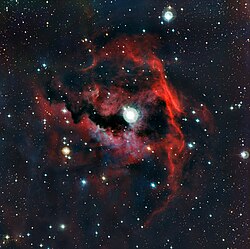| Observation data Epoch J2000 Equinox J2000 | |
|---|---|
| Constellation | Monoceros |
| HD 53367A | |
| Right ascension | 07h 04m 25.5311s [2] |
| Declination | −10° 27′ 15.753″ [2] |
| Apparent magnitude (V) | 7.36 [3] |
| HD 53367B | |
| Right ascension | 07h 04m 25.4868s [4] |
| Declination | −10° 27′ 15.400″ [4] |
| Apparent magnitude (V) | 8.41 [3] |
| Characteristics | |
| HD 53367A | |
| Spectral type | B0IV/Ve [5] |
| HD 53367B | |
| Spectral type | B1Ve [6] |
| Astrometry | |
| HD 53367A | |
| Proper motion (μ) | RA: −3.741 [2] mas/yr Dec.: +1.772 [2] mas/yr |
| Parallax (π) | 0.8199±0.2114 mas [2] |
| Distance | 990±50 [7] pc |
| Orbit [7] | |
| Primary | HD 53367Aa |
| Companion | HD 53367Ab |
| Period (P) | 367.7 d |
| Semi-major axis (a) | 2.6 - 2.7 mas |
| Eccentricity (e) | 0.5 |
| Inclination (i) | 53.6 - 55.3° |
| Semi-amplitude (K1) (primary) | 20.3 km/s |
| Details [7] | |
| HD 53367Aa | |
| Mass | 12.19±2.18 M☉ |
| Radius | 4.2 - 4.3 R☉ |
| Luminosity | 11,000 L☉ |
| Surface gravity (log g) | 4.25 - 4.27 cgs |
| Temperature | 28,400 - 28,600 K |
| HD 53367Ab | |
| Mass | 4.90±0.52 M☉ |
| Radius | 2.5 - 8.0 R☉ |
| Luminosity | 377 - 513 L☉ |
| Surface gravity (log g) | 3.32 - 4.34 cgs |
| Temperature | 9,000 - 17,500 K |
| Age | 0.7±0.2 Myr |
| Other designations | |
| BD−10 1848, HD 53367, HIP 34116, SAO 152320, GSC 05385-02103, V750 Mon, 2MASS J07042551-1027156 [8] | |
| Database references | |
| SIMBAD | data |
HD 53367 is a triple star system in the constellation of Monoceros. The primary star was identified as a variable Herbig Ae/Be star in 1989. [6] Its companion, spectroscopically discovered in 2006, is a pre-main-sequence star with an average separation of 1.7 AU. [1] The star system is embedded in the extended nebula IC 2177.
The binary HD 53367A is part of the hierarchical triple star system RST 3489, with an additional Herbig Ae/Be star HD 53367B of spectral class B1Ve at a projected separation of 0.6″. All stars in the system belong to the star-forming CMa OB1 association. [6] The Hipparcos, [9] Gaia Data Release 2, [10] and Gaia Data Release 3 [2] parallax values for HD 53367A are highly discrepant, but the system is thought to be about 1,000 parsecs away. [11] [7]

